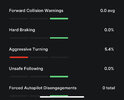AlanSubie4Life
Efficiency Obsessed Member
" We combine your daily Safety Scores (up to 30 days) into a mileage-weighted average to calculate the aggregated Safety Score, which is displayed on the main ‘Safety Score’ screen of the Tesla app."Don’t know if they just average the daily scores to get your weekly safety score but I’d guess yes
So I interpret this to mean they are not simply going to look at all the data on say, unsafe following, and figure out that overall percentage, and incorporate that (and the same for the other elements) into the formula.
This makes for some interesting optimization strategies. For example, let's say you had some very bad hard braking, 5% or something, on your first drive of the day. Subsequently, you would not just want to do a lot of miles on that day on AP at a consistent speed - you'd also want to make sure you got a lot of good braking (presumably you could not use AP for this braking improvement process, since those events are masked, whether good or bad, when AP is "used appropriately") on that day to bring down that % number for that day. Otherwise you'd be in a situation where just a very small number of events gets inflated by all those AP miles (with no braking) when it comes to the mileage-weighted Safety Score . If it's a very bad result, and you really don't think you'd be able to get the number down even with some more driving, you might well want to avoid driving for the rest of that day, to avoid having the weight of those mistakes be high in the aggregated safety score. Whatever you do, you have to make sure that you bring down those percentages, and the more miles you've got on that day, the more important that those % numbers are low.
If they were just doing the aggregate of each event type over the entire window the result could be very different. In that case, the only thing AP miles would do is help with overall masking of events, and also bring down the FCW number.



